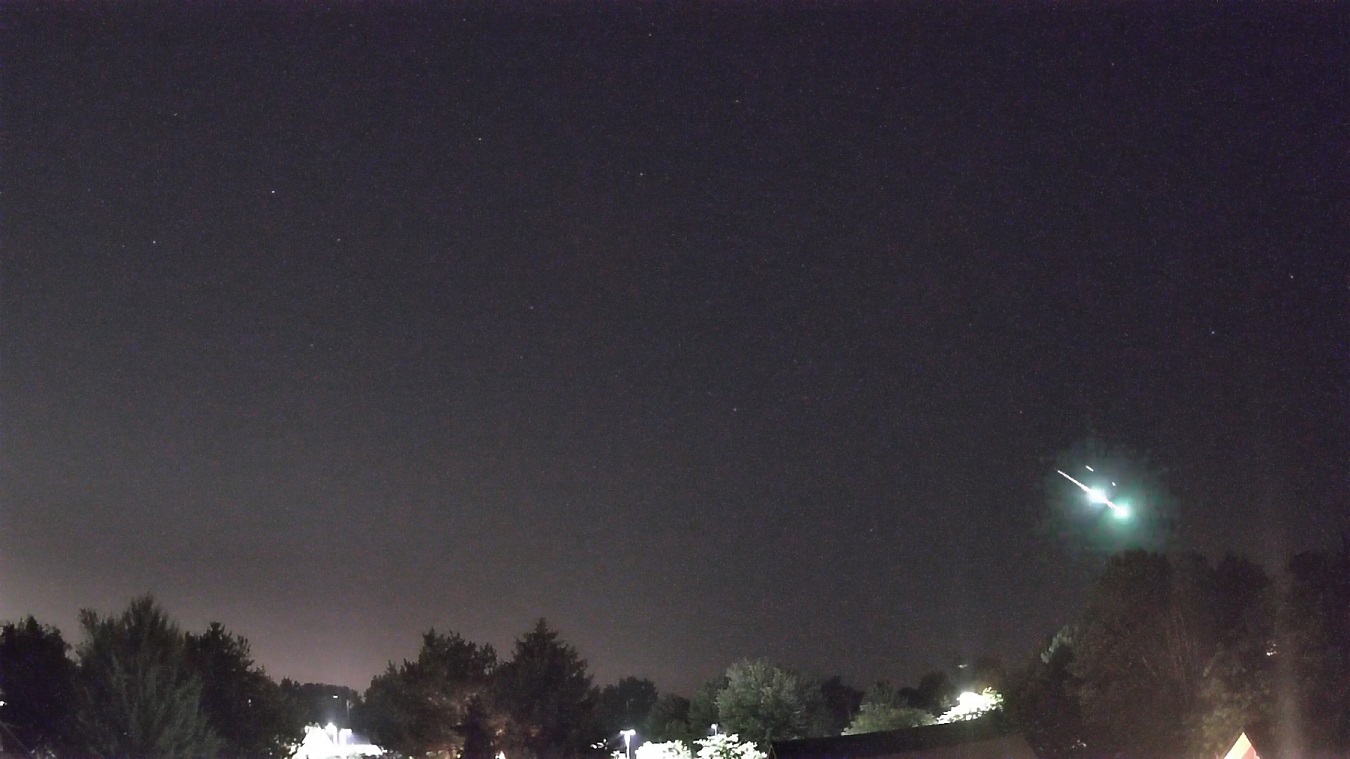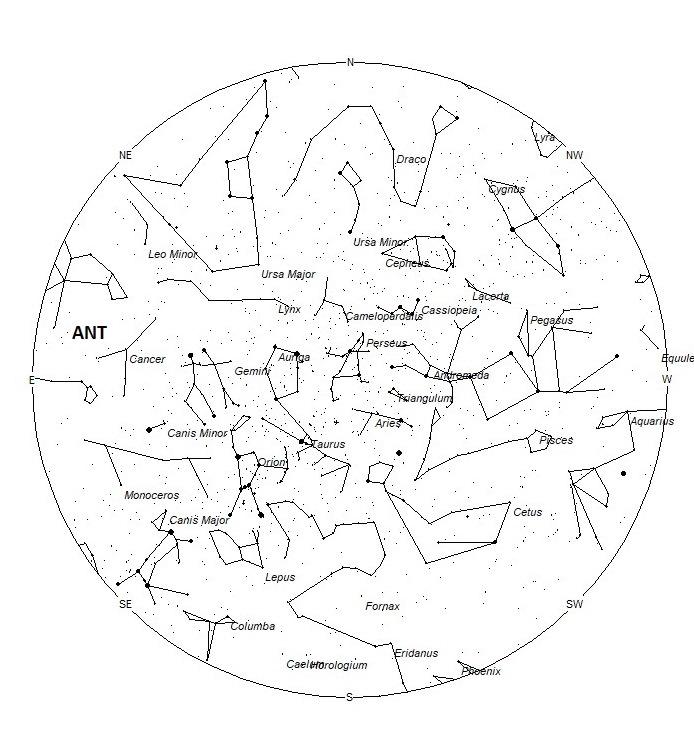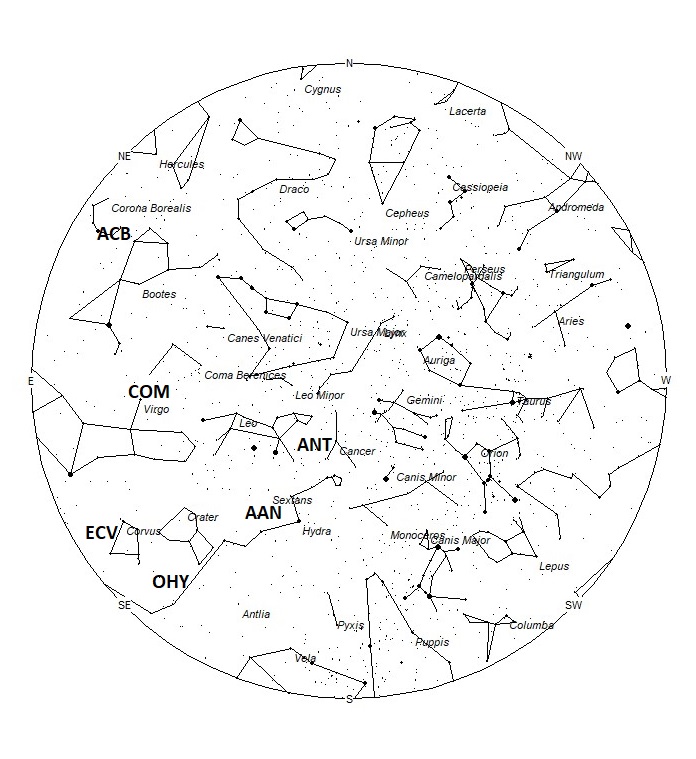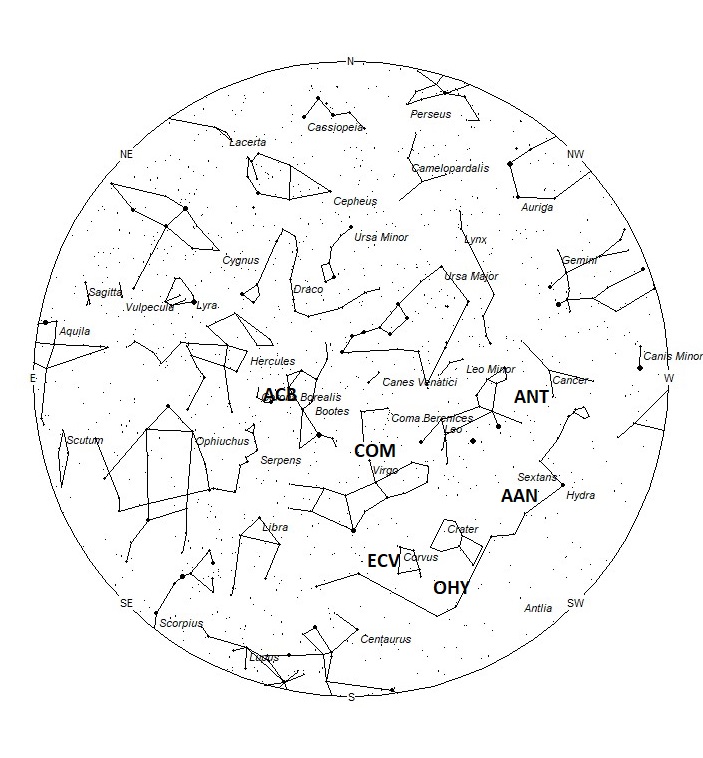 Jordan Ragsdale captured this double-bursting fireball using his AllSky Camera System on July 25, 2023, at 3:07 MDT (9:07 UT) from Eagle, Idaho, USA. ©Jordan Ragsdale
Jordan Ragsdale captured this double-bursting fireball using his AllSky Camera System on July 25, 2023, at 3:07 MDT (9:07 UT) from Eagle, Idaho, USA. ©Jordan RagsdaleDuring this period, the moon reaches its last quarter phase on Friday February 2nd. At that time the moon will lie 90 degrees west of the sun and will rise near 02:00 local standard time (LST) on February 3rd. This weekend the waning gibbous moon will rise during the early evening hours and will obscure all but the brighter meteors the remainder of the night. This is a difficult time to view meteor activity with low rates and moonlight most of the night. The estimated total hourly rates for evening observers this weekend should be near 4 as seen from mid-northern latitudes (45N) and 3 as seen from tropical southern locations (25S) For morning observers, the estimated total hourly rates should be near 15 as seen from mid-northern latitudes (45N) and 11 as seen from tropical southern locations (25S). The actual rates seen will also depend on factors such as personal light and motion perception, local weather conditions, alertness, and experience in watching meteor activity. Rates are reduced due to moonlight. Note that the hourly rates listed below are estimates as viewed from dark sky sites away from urban light sources. Observers viewing from urban areas will see less activity as only the brighter meteors will be visible from such locations.
The radiant (the area of the sky where meteors appear to shoot from) positions and rates listed below are exact for Saturday night/Sunday morning January 27/28. These positions do not change greatly day to day so the listed coordinates may be used during this entire period. Most star atlases (available at science stores and planetariums) will provide maps with grid lines of the celestial coordinates so that you may find out exactly where these positions are located in the sky. I have also included charts of the sky that display the radiant positions for evening, midnight, and morning. The center of each chart is the sky directly overhead at the appropriate hour. These charts are oriented for facing south but can be used for any direction by rotating the charts to the desired direction. A planisphere or computer planetarium program is also useful in showing the sky at any time of night on any date of the year. Activity from each radiant is best seen when it is positioned highest in the sky, either due north or south along the meridian, depending on your latitude. Radiants that rise after midnight will not reach their highest point in the sky until daylight. For these radiants, it is best to view them during the last few hours before dawn. It must be remembered that meteor activity is rarely seen at its radiant position. Rather they shoot outwards from the radiant, so it is best to center your field of view so that the radiant lies toward the edge and not the center. Viewing there will allow you to easily trace the path of each meteor back to the radiant (if it is a shower member) or in another direction if it is sporadic. Meteor activity is not seen from radiants that are located far below the horizon. The positions below are listed in a west to east manner in order of right ascension (celestial longitude). The positions listed first are located further west therefore are accessible earlier in the night while those listed further down the list rise later in the night.
These sources of meteoric activity are expected to be active this week
Details on each source will continue next week when viewing conditions are more favorable.
Those interested in detecting meteors via radio waves may start noticing activity from the Capricornid/Sagittarids (DCS). These meteors can be detected from January 13 through February 4, with maximum activity occurring near February 1st. These meteors would be best detected during the morning hours of 8-10am, when the radiant lies approximately half-way up in the sky. It should be noted that meteors do not emit radio waves, but they act as mirrors and reflect radio waves from distant transmitters which aren’t heard otherwise. This is called forward scatter, opposed to backscatter where the transmitter and receiver are at the same place (radar). For practical reasons the frequency range 50 – 150 MHz (wavelength 6 m – 2 m) is used. This includes amongst others the FM band and TV transmitters which haven’t switched yet to digital. Most reflections are short (less than a second), but brighter meteors can cause reflections lasting minutes. The shortest radio reflections are caused by faint meteors, fainter than visual ones. Radio reflections can be observed regardless of daylight or clouds, allowing more complete views of streams. For those interested in meteor observing via radio waves we invite you to visit RMOB.
You can keep track of the activity of these meteor showers as well as those beyond the limits of visual observing by visiting the NASA Meteor Shower Portal. You can move the sky globe to see different areas of the sky. Colored dots indicate shower meteors while white dots indicate sporadic (random) activity. The large orange disk indicates the position of the sun so little activity will be seen in that area of the sky.
The list below offers the information in tabular form of the showers that I feel are within reach of the visual observer to discern. Hourly rates are often less than one so these sources are rarely listed as visual targets in most meteor shower lists. If you are like me though and wish to associate as many meteors as possible with known sources, then you will appreciate these listings. Before listing meteors from these obscure sources, you should attempt to prove these meteors belong to them and are not chance alignments of sporadic meteors. You can note parameters such as duration, length, radiant distance and the elevation of each meteor to help compute the probability of shower association. It should be remembered that slow meteors can be seen from fast showers, but fast meteors cannot be produced from slow showers. Slower showers are those with velocities less than 35/km per second. Slow meteors can appear from fast showers when they appear close to the radiant or low in the sky. The table located on page 22 of the IMO’s 2024 Meteor Shower Calendar is a big help in aiding in the identification of meteors. If you record the length and duration of each meteor, you can use this chart to check the probability of the meteor belonging to a shower of known velocity. If the angular velocity is similar to the figure in the table, then your meteor probably belongs to that shower. Rates and positions are exact for Saturday night/Sunday morning.
| SHOWER | DATE OF MAXIMUM ACTIVITY | CELESTIAL POSITION | ENTRY VELOCITY | CULMINATION | HOURLY RATE | CLASS |
| RA (RA in Deg.) DEC | Km/Sec | Local Standard Time | North-South | |||
| Anthelions (ANT) | – | 09:24 (141) +14 | 30 | 01:00 | 1 – <1 | II |
| alpha Antliids (AAN) | Jan 27 | 10:16 (154) -08 | 44 | 02:00 | <1 – <1 | IV |
| omicron Hydrids (OHY) | Feb 01 | 11:42 (176) -33 | 58 | 03:00 | <1 – <1 | IV |
| Comae Berenicids (COM) | Dec 16 | 13:02 (195) +13 | 63 | 05:00 | <1- <1 | II |
| eta Corvids (ECV) | Jan 21 | 13:06 (197) -19 | 68 | 05:00 | <1- <1 | IV |
| alpha Coronae Borealids (ACB) | Jan 28 | 15:27 (232) +28 | 57 | 08:00 | <1 – <1 | IV |
Class Explanation: A scale to group meteor showers by their intensity:
- Class I: the strongest annual showers with Zenith Hourly Rates normally ten or better.
- Class II: reliable minor showers with ZHR’s normally two to ten.
- Class III: showers that do not provide annual activity. These showers are rarely active yet have the potential to produce a major display on occasion.
- Class IV: weak minor showers with ZHR’s rarely exceeding two. The study of these showers is best left to experienced observers who use plotting and angular velocity estimates to determine shower association. These weak showers are also good targets for video and photographic work. Observers with less experience are urged to limit their shower associations to showers with a rating of I to III.
 American Meteor Society
American Meteor Society



Hello, I work at Denver Health Hospital in Denver Colorado. I came out to walk for my break and as I was walking south on 7th and Bannock St, I happened to look up to the sky facing south and seen a bright streak and then a bright flash at the end that has to be no higher than one city block length high from the ground as the flash happened, as it was decending about 100 to 150 ft above street level just south of the intersection at 6th and Bannock St in Denver Colorado…..IT WAS SO BEAUTIFUL
I’m apologize, I was so excited, I didn’t leave the time, but I seen it @ 23:05 and the only picture I have of it is photographed in my memory
01/28/2024 @ 23:05
Hallo I am in Kenya Taita Taveta County, I have seen streaks of fire in the sky at 19:44 hrs EAT
Last night about 850pm we saw a blue streak low from east to NE across the sky. Looked blue. Do you know what that was.
Art, if you provide us with your location we can try to verify if this was a meteor or not.
I saw a comet or asteroid or meteor on Jan. 21 2024. San Diego California looking South. It looked like a comet to me because it had somewhat of a tail. It was white or light blue. It looked like a piece broke off and burned in the atmosphere. The piece was red orange. If anyone knows what it was let me know please. Thanks.